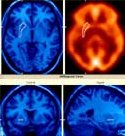EMOTIONS: OBSERVING
THE FUSION
BETWEEN BODY, MIND, AND SOCIETY
The danger of free speech does not lie in the
menace of ideas, but in the menace of emotions. If words were merely logical devices, no one
would fear them. But when they impinge upon a moron they set off his hormones, and so they
are justifiably feared. Complete free speech, under democracy, is possible only in a foreign
language.
--H.L. Mencken, 1929
By starving emotions we become humorless,
rigid
and stereotyped; by repressing them we become literal, reformatory and
holier-than-thou; encouraged they perfume life; discouraged, they poison
it.
--Joseph Collins
What would life be like if there was no feeling, no
emotions associated with everyday experiences? What is the meaning of the
"Star Trek" Spock character, the epitome of all logic and no
feeling? Feelings carry with them impulses--impulses which often lead to
behaviors which, in turn, often require justification. One wonders, in fact, of the
percentage of behavior that derives from rational calculation versus from
this spontaneous, immeasurable, impulsive quality of the human condition.
 For a number of reasons, the study of emotions has
become one of the hottest research areas in social psychology. Such was
not always the case. As the social sciences matured in the post-war years,
emotions were often regarded as some peripheral "error term"
in their rational choice models of decision-making. Like body hair and
finger nails, they were often seen as some legacy of our animalistic past--involving
some vestigial brain circuitry that once somehow enhanced the survival chances
of protohuman primates. These natural events, occurring involuntarily,
supposedly remained outside of the realms of intelligence, language, culture,
and of free will. They were feelings that were to be controlled if not
suppressed, to be "grown out of" like the tantrums of a young
child.
For a number of reasons, the study of emotions has
become one of the hottest research areas in social psychology. Such was
not always the case. As the social sciences matured in the post-war years,
emotions were often regarded as some peripheral "error term"
in their rational choice models of decision-making. Like body hair and
finger nails, they were often seen as some legacy of our animalistic past--involving
some vestigial brain circuitry that once somehow enhanced the survival chances
of protohuman primates. These natural events, occurring involuntarily,
supposedly remained outside of the realms of intelligence, language, culture,
and of free will. They were feelings that were to be controlled if not
suppressed, to be "grown out of" like the tantrums of a young
child.
But these feeling states were not about to be so easily
explained away. Emotions have the power to override even the most rational
decisions. Studies confirmed what Plato had postulated thousands
of years earlier: affect and not cognition is the major determinant of
action and belief. Further, consider the affective components of the personal and social needs systems addressed
elsewhere:
- the emotions associated with both physical (and social) survival: the feelings of
fear, anxiety, hope and faith.
- the emotions of belonging and connectedness: feelings of communion, love,
empathy, loyalty, nationalism, and hatred of outgroups.
- emotions checking the selfish drives of individuals: guilt, fear of rejection and
social ostracism, dread of loneliness.
- emotions which maintain the social order. Este Armstrong et al.
("Relative size of the anterior thalamic nuclei differentiates anthropoids by social system."
Brain, Behavior and Evolution, 1987, 30:263-71) observe how damage to the
limbic system (the seat of emotions) alters dominance hierarchies and severely disrupts
grooming, sexual, maternal, and other social behaviors.
- the emotions of control and being controlled: emotions of social status (i.e.,
feelings of deference or superiority, intimidation and awe), confidence, and rage. In A
Social Interactional Theory of Emotion, Theodore Kemper develops how "social
relationships are linked through emotions to physiological processes," such as how power
triggers fear or how the withdrawal of status triggers anger.
EXPRESS IT AND FEEL IT:
WHERE
PHYSIOLOGY, PSYCHOLOGY AND SOCIOLOGY COMBINE
In The Purloined Letter Edgar Allen Poe wrote that to discover how
wise, stupid, good, or evil a person is or what he might be thinking at the moment, "I fashion
the expression of my face, as accurately as possible, in accordance with the expression of his,
and then wait to see what thoughts or sentiments arise in my mind or heart." Recent research
indicates that we are emotionally hardwired in such a way that by fashioning the correct facial
expression for a particular emotion one can activate the centers of the brain and actually
produce the affective state. Add to this humans' tendency to mimic others (who knows,
perhaps that's why long-married spouses come to resemble each other) and we have some
insight into the workings of emotional contagion.

EMOTIONAL INTELLIGENCE
There is evidence suggesting that EQ, emotional intelligence, and not IQ is the key
to success. As can be inferred from the article on the right, EQ is what allows individuals to
"successfully" anticipate and respond to others' actions--which is the essence of social life
(and why, according to sociobiologists, our brains got so large). One
wonders what the relationship is between individuals' EQ
and the number of auto accidents they've been involved in. Anyway,
recognition of this self facet has given rise to the emotional literacy movement.
- Online
Bibliography of Emotions and Emotional Intelligence
- EQ Today: Making the Most of Emotional Intelligence
- "Elusive EQ" in
The New Scientist
- The Consortium for Research on Emotional Intelligence in Organizations
- Body, Mind
& Spirit -- What's your EQ?
SOCIALLY TRIGGERING VARIOUS EMOTIVE
STATES
Given their potency in shaping (and flavoring) the
relationships between self and society, it is not surprising the extent to which social institutions
attempt to reinforce or reject individuals' affective states through:
- music;
- ceremony, such as the use of pain in rites of
passage;

- propaganda;
- humor;
- color--why
are professional sports teams with black uniforms, especially in hockey and football, among the
most penalized? For other thoughts about color psychology check out:
- Color Matters
- Grantastic Designs has an interesting table showing how various professions differently interpret the same color
- COLORCOM "Marketing psychologists state that a lasting impression is made within ninety seconds and that color accounts for 60% of the acceptance or rejection of an object, person,
place, or circumstance."
- architectural design;
- and even smell: Some companies are investigating mood-altering fragrance
systems for the work-place; for over a decade, International Flavors and Fragrances (a New
York company) has been testing aromas associated with alertness, relaxation and sexual
excitement.
Michel Foucault develops a historical shift in the technology of punishment from
the body to the emotions--"the technology of the educators, the psychologists and the
psychiatrists."
RESEARCH IDEAS: CASE STUDIES IN
EMOTIONOLOGY
EMPATHY
Perhaps the distinctive human trait is not the use of symbols
but rather the human primate's ability to have empathy for others who are not of one's own
family, tribe, culture, nation, or even species--despite the normal tendency to only have
empathy toward those perceived to be similar to one's self. This sentiment is perhaps the
foundation on which the moral emotions are built, a basic check against temptations toward
cruelty. Two of the basic predictors of adulthood empathy are childhood relationships with
both mother and father, where parents spent time with their children and were responsive to
their emotional needs.
HAPPINESS
 The Declaration of Independence states "We hold these
truths to be self-evident--that all men are created equal; that they are endowed by their Creator
with certain unalienable rights; that among these are life, liberty, and the pursuit of happiness."
The Declaration of Independence states "We hold these
truths to be self-evident--that all men are created equal; that they are endowed by their Creator
with certain unalienable rights; that among these are life, liberty, and the pursuit of happiness."
But what is happiness? Is it synonymous with pleasure, satisfaction, or well-being?
Can one experience happiness if one has never experienced its antithesis? Is happiness a state
that one can constantly maintain for days, weeks or even months, or can there be too much of a
good thing? Does one really know if they are presently happy or is the state something that is
only realized in reflection (i.e., "I really didn't appreciate how happy I was then"). Is
happiness a certain biological-psychological condition, such as the release of the bodily-
produced opiates called endorphins, or is it a socially defined subjective state?
As central as such questions seem and given the motivational primacy of the pursuit of
happiness, it is curious that the topic of happiness was not even indexed in Psychological
Abstracts International until 1973.
- Ruut Vennhoven's
The World Database of Happiness (overview of collections
here)
- Pew Research Center's 2006 "Are We Happy Yet?" survey
-
-
Of all emotional impulses, anger ranks among the toughest
to control. It's genesis is typically social: either from the sense of being somehow trespassed
against (i.e., challenges to one's esteem) or from the sense of violation of one's social contract
with another (i.e., another's failure to live up to their bargain). Given the threat of this feeling
state to social solidarities, it is not surprising how cultures have attempted to dissipate or
redirect its power. Manners, for instance, are mechanisms for anger management, as are the
use of gossip, ridicule, ostracism and shame (see Carol Tavris, Anger: The
Misunderstood Emotion). In The Psychology of Love, Peter and Carol
Stearns develop how anger became a social problem during the eighteen century because of the
enhanced value placed on family life-- which had become a supposedly anger-free refuge from
an increasingly urbanized and anomic world, and where the marital bond becoming based on
emotion (e.g., love) rather than on economic interdependency --and because of Enlightenment
prescriptions for rationally controlling one's impulses. The Stearns go so far as to argue that
the participations of Victorian wives in social protest movements was partially fueled by their
displaced marital anger.
-
culturefront online (NY Council for the Humanities) special issue on anger
HATE
When Alex Haley visited the Trinity campus in 1991,
he spoke of his Playboy interview with George Lincoln Rockwell,
the former head of the American Nazi Party. Observed this graduate of Brown
University and former Air Force pilot, the easiest thing in the world to
sell is hate.
GUILT AND SHAME
Though shame exists in all cultures in
individualistic cultures like the United States it is self-oriented while in collectivist cultures like
Japan shame is linked to others (where, for instance, a child's deviance brings shame to its
parents).
JEALOUSY AND ENVY
These two related feelings involve social challenges to their
experiencers' personal bases of pride, core senses of self, and central social bonds.
FAKE FEELINGS
Patrick West, in
Conspicuous Compassion, argues that "we live in a post-emotional age,
one characterized by crocodile tears and manufactured emotions" (p. 2). Reflecting the curious mass outpourings of grief for Princess Di
and other celebrities, he writes "Mourning sickness is a religion for the lonely crowd that no longer subscribes to orthodox churches. Its flowers and teddies are its rites, its collective
minutes' silences its liturgy and mass. But these new bonds are phony, ephemeral and cynical" (p.66).
So how good are you at detecting authentic from contrived
expressions of emotion? Take the BBC's "Spot
the Fake Smile" test.
THE SOCIAL DISTRIBUTION OF EMOTIVE
STATES
In the 1996 NORC General Social
Survey American adults were asked of their affective states. Below is the age
distribution of some of these feelings. Observe how older people are generally less likely to
experience the emotional lows and highs of other age groups.
On how many days in
the past 7 days have you: |
18-29 |
30-39 |
40-49 |
50-59 |
60-69 |
70+ |
felt ashamed of something
you'd done (%no days) |
73% |
72% |
71% |
82% |
80% |
83% |
felt fearful about something
that might happen to you
(% no days) |
54 |
56 |
55 |
60 |
71 |
70 |
worried alot about little
things (%no days) |
22 |
25 |
30 |
38 |
44 |
41 |
felt contented
(% every day) |
29 |
29 |
33 |
39 |
51 |
51 |
felt anxious and tense
(% no days) |
21 |
23 |
25 |
34 |
39 |
46 |
felt so restless that you
couldn't sit long in a
chair (% 4 or more days) |
24 |
20 |
16 |
13 |
14 |
19 |
felt excited about or
interested in something
(% 5 or more days) |
35 |
37 |
34 |
38 |
40 |
29 |
felt overjoyed about
something (% no days) |
29 |
37 |
44 |
45 |
45 |
53 |
To illustrate the different emotive worlds experienced by members of various
social classes, consider the table below. Observe in total that 17% of Americans felt fearful
about something that might happen to them 3 or more days during the prior week. From the
TOTAL row, note that females were slighly more fearful than males. From the TOTAL
column observe how members of the lower class were nearly four times more likely to have
been fearful than upper class members. The higher the social class, the greater the sex
discrepancy in fear.
PERCENT FEELING FEARFUL 3 OR MORE
DAYS
| CLASS |
MALE |
FEMALE |
TOTAL |
| Lower |
31% |
31% |
31% |
| Working |
17 |
17 |
17 |
| Middle |
11 |
17 |
14 |
| Upper |
5 |
11 |
8 |
| TOTAL |
15 |
18 |
17 |
RESOURCES

- See a talk with Joseph
Ledoux, "Parallel Memories: Putting Emotions Back into the
Brain"
- Thomas Scheff's homepage, with articles and book chapters
- David Heise's homepage, with elaborations
of his Affect Control Theory
- The Science of Emotions Neurobiological research at the University of Wisconsin Madison
- Donelson Forsyth's
"Motivation and Emotion" page
- The Institute for
Rational-Emotive Therapy

 Return to Social Psychology Index
Return to Social Psychology Index
 For a number of reasons, the study of emotions has
become one of the hottest research areas in social psychology. Such was
not always the case. As the social sciences matured in the post-war years,
emotions were often regarded as some peripheral "error term"
in their rational choice models of decision-making. Like body hair and
finger nails, they were often seen as some legacy of our animalistic past--involving
some vestigial brain circuitry that once somehow enhanced the survival chances
of protohuman primates. These natural events, occurring involuntarily,
supposedly remained outside of the realms of intelligence, language, culture,
and of free will. They were feelings that were to be controlled if not
suppressed, to be "grown out of" like the tantrums of a young
child.
For a number of reasons, the study of emotions has
become one of the hottest research areas in social psychology. Such was
not always the case. As the social sciences matured in the post-war years,
emotions were often regarded as some peripheral "error term"
in their rational choice models of decision-making. Like body hair and
finger nails, they were often seen as some legacy of our animalistic past--involving
some vestigial brain circuitry that once somehow enhanced the survival chances
of protohuman primates. These natural events, occurring involuntarily,
supposedly remained outside of the realms of intelligence, language, culture,
and of free will. They were feelings that were to be controlled if not
suppressed, to be "grown out of" like the tantrums of a young
child.


